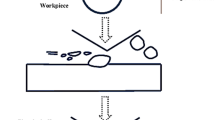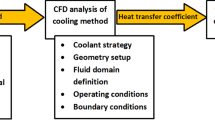Abstract
The high temperature generated when machining aerospace alloys namely, titanium and nickel alloys, accelerate the tool wear rate and affects the physical properties of the machined surface. Flood coolant is usually the effective traditional solution to dissipate the heat and reduce its negative impact on tool performance and surface integrity. The disposal of the coolant causes environmental concerns, and the generated fumes during machining also present health concerns. Minimum quantity lubricant is presented as an alternative coolant strategy to reduce the amount of used coolant and environmental concerns associated with flood coolant. Experimental investigations showed that MQL does not offer the same results obtained when using flood coolant during machining titanium and Inconel. However, the addition of nano-additives significantly improved the performance of MQL. In this work, an integrated model (i.e., finite element and finite volume) is developed to analyze various unique aspects of machining with nano-fluids under minimum quantity lubrication during cutting Inconel 718 and Ti-6Al-4V alloys. These aspects include the heat transfer characteristics of the resultant nano-cutting fluid, the interactions between the cutting tool and workpiece, the generated cutting temperature at different zones, and resulting residual stresses. The investigation was carried out through two main phases. A 2-D axisymmetric computational fluid dynamics (CFD) model is developed to simulate the thermal effect of resultant nano-mist and obtain the thermal characteristics of the nano-fluid. The obtained results are then used in the finite element model to simulate the machining process with nano-fluid. The average heat convection coefficients results provided from the proposed CFD model at standard room temperature demonstrated a good agreement with the theoretical values calculated throughout this work. Also, the simulated and experimental cutting forces showed better agreement in the case of cutting test performed without nano-additives (accuracy % ≈ 90%) than the cutting test performed with nano-additives (accuracy % ≈ 82.3%). This work presents a first attempt in the open literature to simulate the machining processes using MQL-nano-fluid.
Similar content being viewed by others
References
Miller S (1995) Advanced materials mean advanced engines. Interdiscip Sci Rev 20(4):117–129
Davim JP (2011) Machining of hard materials. Springer Science & Business Media
Gupta MK, Sood PK, Singh G, Sharma VS (2017) Experimental investigation and optimization on MQL-assisted turning of Inconel-718 super alloy. Adv Manuf Technol (pp. 237–248). Springer, Cham
Wang ZY, Rajurkar KP, Fan J, Lei S, Shin YC, Petrescu G (2003) Hybrid machining of Inconel 718. Int J Mach Tools Manuf 43(13):1391–1396
Alauddin MMBMHM, Mazid MA, El Baradi MA, Hashmi MSJ (1998) Cutting forces in the end milling of Inconel 718. J Mater Process Technol 77(1–3):153–159
Dudzinski D, Devillez A, Moufki A, Larrouquere D, Zerrouki V, Vigneau J (2004) A review of developments towards dry and high speed machining of Inconel 718 alloy. Int J Mach Tools Manuf 44(4):439–456
Kadam GS, Pawade RS (2017) Surface integrity and sustainability assessment in high-speed machining of Inconel 718—an eco-friendly green approach. J Clean Prod 147:273–283
Ezugwu E, Wang Z (1997) Titanium alloys and their machinability—a review. J Mater Process Technol 68(3):262–274
Shokrani A, Dhokia V, Newman ST (2012) Environmentally conscious machining of difficult-to-machine materials with regard to cutting fluids. Int J Mach Tools Manuf 57:83–101
Klocke F, Eisenblätter G (1997) Dry cutting. CIRP Annals-Manufacturing Technology 46(2):519–526
Kamata Y, Obikawa T (2007) High speed MQL finish-turning of Inconel 718 with different coated tools. J Mater Process Technol 192:281–286
Cabanettes F, Faverjon P, Sova A, Dumont F, Rech J (2017) MQL machining: from mist generation to tribological behavior of different oils. Int J Adv Manuf Technol 90(1–4):1119–1130
Eltaggaz A, Zawada P, Hegab HA, Deiab I, Kishawy HA (2017) Coolant strategy influence on tool life and surface roughness when machining ADI. Int J Adv Manuf Technol, 1–13
Kishawy H (2002) An experimental evaluation of cutting temperatures during high speed machining of hardened D2 tool steel
Kishawy H, Li L, El-Wahab A (2006) Prediction of chip flow direction during machining with self-propelled rotary tools. Int J Mach Tools Manuf 46(12):1680–1688
Li L, Kishawy HA (2006) A model for cutting forces generated during machining with self-propelled rotary tools. Int J Mach Tools Manuf 46(12–13):1388–1394
Srikant RR, Rao DN, Subrahmanyam MS, Krishna VP (2009) Applicability of cutting fluids with nanoparticle inclusion as coolants in machining. Proceedings of the Institution of Mechanical Engineers, Part J: Journal of Engineering Tribology 223(2):221–225
Li B, Li C, Zhang Y, Wang Y, Jia D, Yang M, Zhang N, Wu Q, Han Z, Sun K (2017) Heat transfer performance of MQL grinding with different nanofluids for Ni-based alloys using vegetable oil. J Clean Prod 154:1–11
Sharma AK, Tiwari AK, Dixit AR (2015) Progress of nanofluid application in machining: a review. Mater Manuf Process 30(7):813–828
Sharma AK, Tiwari AK, Dixit AR (2016) Effects of minimum quantity lubrication (MQL) in machining processes using conventional and nanofluid based cutting fluids: a comprehensive review. J Clean Prod 127:1–18
Su Y, Gong L, Li B, Liu Z, Chen D (2016) Performance evaluation of nanofluid MQL with vegetable-based oil and ester oil as base fluids in turning. Int J Adv Manuf Technol 83(9–12):2083–2089
Hegab H, Umer U, Deiab I, Kishawy H (2018) Performance evaluation of Ti-6Al-4V machining using nano-cutting fluids under minimum quantity lubrication. Int J Adv Manuf Technol, 1–13
Heigel JC, Whitenton E, Lane B, Donmez MA, Madhavan V, Moscoso-Kingsley W (2017) Infrared measurement of the temperature at the tool–chip interface while machining Ti–6Al–4V. J Mater Process Technol 243:123–130
Lee KM, Huang Y, Ji J, Lin CY (2018) An online tool temperature monitoring method based on physics-guided infrared image features and artificial neural network for dry cutting. IEEE Tran
Pan Z, Shih DS, Tabei A, Garmestani H, Liang SY (2017) Modeling of Ti-6Al-4V machining force considering material microstructure evolution. Int J Adv Manuf Technol 91(5–8):2673–2680
Tahri C, Lequien P, Outeiro JC, Poulachon G (2017) CFD simulation and optimize of LN2 flow inside channels used for cryogenic machining: application to milling of titanium alloy Ti-6Al-4V. Procedia CIRP 58:584–589
Li A, Pang J, Zhao J, Zang J, Wang F (2017) FEM-simulation of machining induced surface plastic deformation and microstructural texture evolution of Ti-6Al-4V alloy. Int J Mech Sci 123:214–223
Jafarian F, Ciaran MI, Umbrello D, Arrazola PJ, Filice L, Amirabadi H (2014) Finite element simulation of machining Inconel 718 alloy including microstructure changes. Int J Mech Sci 88:110–121
Vijayaraghavan V, Garg A, Gao L, Vijayaraghavan R, Lu G (2016) A finite element based data analytics approach for modeling turning process of Inconel 718 alloys. J Clean Prod 137:1619–1627
Chien SEM, Reddy MM, Lee VCC, Sujan D (2017) The study of coated carbide ball end milling tools on Inconel 718 using numerical simulation analysis to attain cutting force and temperature predictive models at the cutting zone. In Materials Science Forum (Vol. 882, pp. 28–35). Trans Tech Publications
Soo S, Aspinwall D, Dewes R (2004) 3D FE modelling of the cutting of Inconel 718. J Mater Process Technol 150(1–2):116–123
Rao B, Dandekar CR, Shin YC (2011) An experimental and numerical study on the face milling of Ti–6Al–4V alloy: tool performance and surface integrity. J Mater Process Technol 211(2):294–304
Thepsonthi T, Özel T (2013) Experimental and finite element simulation based investigations on micro-milling Ti-6Al-4V titanium alloy: effects of cBN coating on tool wear. J Mater Process Technol 213(4):532–542
Zhang S, Li JF, Wang YW (2012) Tool life and cutting forces in end milling Inconel 718 under dry and minimum quantity cooling lubrication cutting conditions. J Clean Prod 32:81–87
Liao YS, Liao CH, Lin HM (2017) Study of oil-water ratio and flow rate of MQL fluid in high speed milling of Inconel 718. Int J Precis Eng Manuf 18(2):257–262
Banerjee N, Sharma A (2016) Development of a friction model and its application in finite element analysis of minimum quantity lubrication machining of Ti-6Al-4V. J Mater Process Technol 238:181–194
Balan ASS, Kullarwar T, Vijayaraghavan L, Krishnamurthy R (2017) Computational fluid dynamics analysis of MQL spray parameters and its influence on superalloy grinding. Mach Sci Technol 21(4):603–616
Rohit JN, Kumar S, Sura Reddy N, Kuppan P, Balan ASS (2016) Computational fluid dynamics analysis of MQL spray parameters and its influence on MQL milling of SS304
Abd Rahim EH, Dorairaju D, Asmuin N, Mantari AR, Hanafi M (2014) Determination of mist flow characteristic for MQL technique using particle image velocimetry (PIV) and computer fluid dynamics (CFD). International Integrated Engineering Summit (IIES 2014), 1-4 December 2014, University Tun Hussein Onn Malaysia, Johor
Pu Z, Umbrello D, Dillon OW Jr, Lu T, Puleo DA, Jawahir IS (2014) Finite element modeling of microstructural changes in dry and cryogenic machining of AZ31B magnesium alloy. J Manuf Process 16(2):335–343
Sun Y, Huang B, Puleo DA, Jawahir IS (2015) Enhanced machinability of Ti-5553 alloy from cryogenic machining: comparison with MQL and flood-cooled machining and modeling. Procedia CIRP 31:477–482
Kleinstreuer C, Feng Y (2011) Experimental and theoretical studies of nanofluid thermal conductivity enhancement: a review. Nanoscale Res Lett 6(1):1–13
Saarinen S (2014) Heat transfer in nanoscale colloids
Lienhard J (2006) Heat transfer by impingement of circular free-surface liquid jets. In Proceedings of 18th National and 7th ISHMT-ASME Heat and Mass Transfer Conference, Guwahati, India
Shen Y (1962) Theoretical analysis of jet-ground plane interaction: Institute of the Aerospace Sciences
Duan CZ, Dou T, Cai YJ, Li YY (2009) Finite element simulation and experiment of chip formation process during high speed machining of AISI 1045 hardened steel. International Journal of Recent Trends in Engineering 1(5):46–50
Oh JW (2013) Experimental investigation and analysis of chip rebonding phenomenon in turning superalloys, The University of Michigan
Kay G (2003) Failure modeling of titanium 6A1-4V and aluminum 2024-T3 with the Johnson-Cook material model final report: Office of Aviation Research Washington, D.C. 20591
Haglund AJ, Kishawy HA, Rogers RJ (2008) An exploration of friction models for the chip–tool interface using an arbitrary Lagrangian–Eulerian finite element model. Wear 265(3–4):452–460
Shet C, Deng X (2000) Finite element analysis of the orthogonal metal cutting process. J Mater Process Technol 105(1):95–109
Hegab H, Umer U, Soliman M, Kishawy HA (2018) Effects of nano-cutting fluids on tool performance and chip morphology during machining Inconel 718. Int J Adv Manuf Technol 96(1–10):3449–3458
Hegab H, Kishawy HA, Gadallah MH, Umer U, Deiab I (2018) On machining of Ti-6Al-4V using multi-walled carbon nanotubes-based nano-fluid under minimum quantity lubrication. Int J Adv Manuf Technol:1–11
Eltaggaz A, Hegab H, Deiab I, Kishawy HA (2018) Hybrid nano-fluid-minimum quantity lubrication strategy for machining austempered ductile iron (ADI). Int J Interact Des Manuf 1–9
Hegab H, Darras B, Kishawy HA (2018) Sustainability assessment of machining with nano-cutting fluids. Procedia Manufacturing 26:245–254
Rahmati B, Sarhan AA, Sayuti M (2014) Morphology of surface generated by end milling AL6061-T6 using molybdenum disulfide (MoS2) nanolubrication in end milling machining. J Clean Prod 66:685–691
El-Wardany TI, Kishawy HA, Elbestawi MA (2000) Surface integrity of die material in high speed hard machining. Part 1: micrographical analysis. J Manuf Sci Eng 122(4):620–631
El-Wardany TI, Kishawy HA, Elbestawi MA (2000) Surface integrity of die material in high speed hard machining. Part 2: microhardness variations and residual stresses. J Manuf Sci Eng 122(4):632–641
Brinksmeier E, Cammett JT, König W, Leskovar P, Peters J, Tönshoff HK (1982) Residual stresses—measurement and causes in machining processes. CIRP Annals-Manufacturing Technology 31(2):491–510
König W, Berktold A, Koch K-F (1993) Turning versus grinding—a comparison of surface integrity aspects and attainable accuracies. CIRP Annals-Manufacturing Technology 42(1):39–43
Funding
The authors acknowledge the support of the Natural Sciences and Engineering Research Council of Canada (NSERC) and the International Scientific Partnership Program ISPP at King Saud University for funding this research work through ISPP# 0059.
Author information
Authors and Affiliations
Corresponding author
Rights and permissions
About this article
Cite this article
Hegab, H., Kishawy, H.A., Umer, U. et al. A model for machining with nano-additives based minimum quantity lubrication. Int J Adv Manuf Technol 102, 2013–2028 (2019). https://doi.org/10.1007/s00170-019-03294-0
Received:
Accepted:
Published:
Issue Date:
DOI: https://doi.org/10.1007/s00170-019-03294-0




